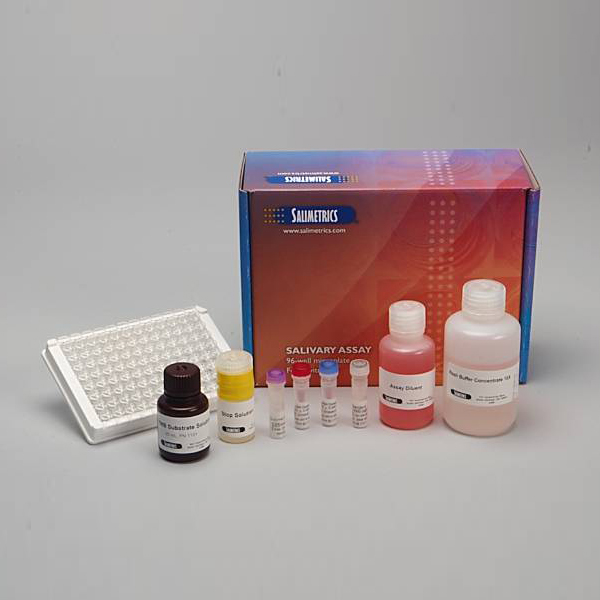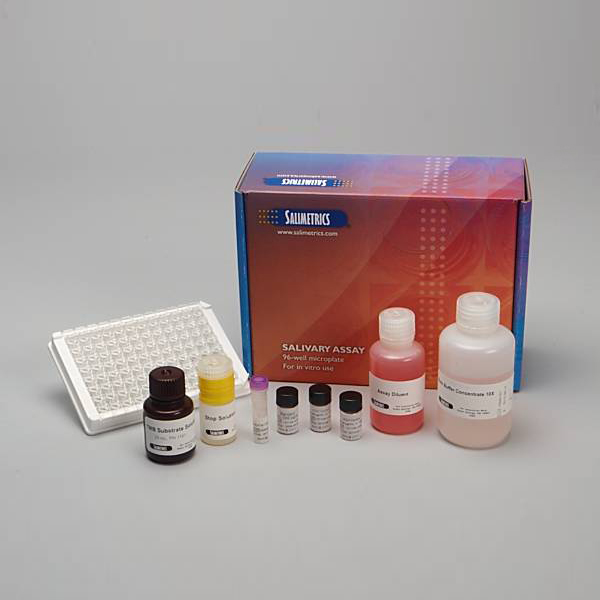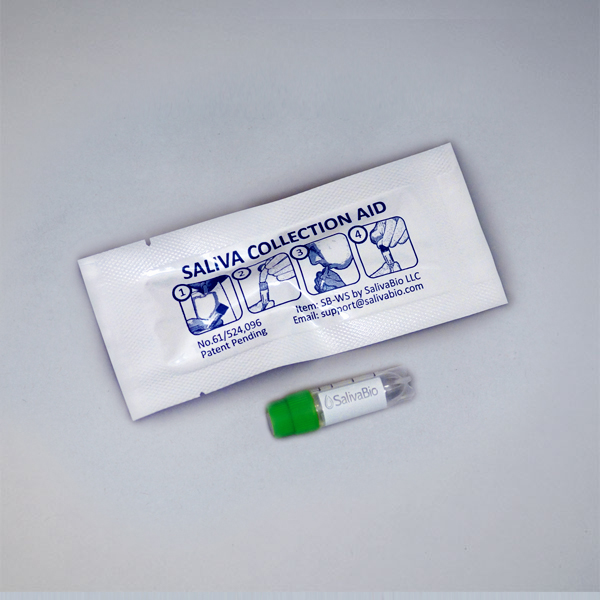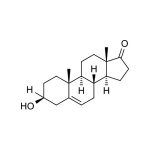Need Help?
Ask an expert
1. How to collect Salivary DHEA
APPROVED SALIVARY DHEA COLLECTION METHODS
Salivary DHEA Collection Protocol
Collection volume, general considerations, and basic guidelines to maximize salivary DHEA sample integrity. Use this analyte-specific collection protocol to plan you collection methodology and sampling schemes.

2. How to Assay for Salivary DHEA
Send Saliva Samples to Salimetrics
Add to StudyEasy and accurate results from the most trusted Salivary Bioscience Laboratory.
All Lab ServicesOrder Code5120
Salivary DHEA ELISA Kit
Add to Study
Salimetrics Assay #1-1202
The Salimetrics Salivary DHEA Enzyme Immunoassay Kit was specifically designed to standardize the detection of DHEA in saliva samples for research and biomedical laboratories. Using a small sample volume, this assay kit has an extended range that spans the expected DHEA levels found in human saliva. The average inter- and intra-assay precision coefficients of variation are low with no deleterious matrix effects often found in saliva which are characterized through dilution- and spike-recovery validation procedures. This DHEA assay kit has also been formatted to minimize cross reactivity for related steroids. DHEA is a major secretory product of the adrenal glands; it is co-released along with cortisol in response to ACTH from the pituitary gland. A major role of DHEA is to act as a circulating precursor of androgens and estrogens in tissues throughout the body, and it has also been associated with immune function. In addition, DHEA is produced directly by the nervous system, where it functions as a neuroactive and neuroprotective factor. Salivary DHEA levels are unaffected by salivary flow rate or salivary enzymes. DHEA exhibits a diurnal rhythm similar to cortisol, with highest levels in the morning after awakening, followed by a decline throughout the afternoon and evening. Read More...| Assay Protocol |
|---|
| Rev. 12.08.21
|
| Specifications | |
|---|---|
| Catalog#: | 1-1202 |
| Regulatory Status: | RUO |
| Format: | 96-well plate |
| Assay Time: | ~ 4 hrs |
| Sample Volume/Test: | 50 µL |
| Sensitivity: | 5 pg/mL |
| Assay Range: | 10.2 pg/mL - 1000 pg/mL |
| Storage Requirements: | 2-8°C |
| Tests Per Kit | |
|---|---|
| Singlet: | 76 |
| Duplicate: | 38 |
| Target Analyte |
|---|
Technical Documentation
Assay Kit Overview
Intended Use
The Salimetrics DHEA Enzyme Immunoassay Kit is a competitive immunoassay specifically designed and validated for the quantitative measurement of salivary Dehydroepiandrosterone (DHEA). It is not intended for diagnostic use. It is intended only for research use in humans and some animals. Salimetrics has not validated this kit for serum or plasma samples.
Introduction
DHEA is a major secretory product of the adrenal glands; it is co-released along with cortisol in response to ACTH from the pituitary gland. Circulating levels of DHEA decline rapidly after birth and remain low until about the age of 6-8, when they begin to rise. This prepubertal onset of adrenal production, known as the adrenarche, involves enzymatic changes within the adrenal gland. DHEA levels increase until the third decade of life, then they begin to decline again. Significant reductions occur after the age of 50. A major role of DHEA is to act as a circulating precursor for conversion to androgens and estrogens in tissues throughout the body, and it has also been associated with immune function. In addition, DHEA is produced directly in the nervous system, where it functions as a neuroactive and neuroprotective factor. In blood, only 1-10% of DHEA is in its unbound or biologically active form. The remaining DHEA is bound to serum proteins. Unbound DHEA enters the saliva via intracellular mechanisms; the majority of DHEA in saliva is non-protein bound. Salivary DHEA levels are unaffected by salivary flow rate or salivary enzymes. DHEA exhibits a diurnal rhythm similar to cortisol, with highest levels in the morning after awakening, followed by a decline throughout the afternoon and evening.
Salivary DHEA Assay Principle
This is a competitive immunoassay kit. DHEA in standards and samples compete with DHEA conjugated to horseradish peroxidase for the antibody binding sites on a microtitre plate. After incubation, unbound components are washed away. Bound DHEA Enzyme Conjugate is measured by the reaction of the horseradish peroxidase enzyme to the substrate tetramethylbenzidine (TMB). This reaction produces a blue color. A yellow color is formed after stopping the reaction with an acidic solution. The optical density is read on a standard plate reader at 450 nm. The amount of DHEA Enzyme Conjugate detected is inversely proportional to the amount of DHEA present in the sample.
Diagnostic Salivary DHEA ELISA Kit (CE Mark)
Add to Study
Salimetrics Assay #1-2212 (in vitro diagnostic use)
The Salimetrics Salivary DHEA Enzyme Immunoassay Kit was specifically designed to standardize the detection of DHEA in saliva samples for research and biomedical laboratories. Using a small sample volume, this assay kit has an extended range that spans the expected DHEA levels found in human saliva. The average inter- and intra-assay precision coefficients of variation are low with no deleterious matrix effects often found in saliva which are characterized through dilution- and spike-recovery validation procedures. This DHEA assay kit has also been formatted to minimize cross reactivity for related steroids. DHEA is a major secretory product of the adrenal glands; it is co-released along with cortisol in response to ACTH from the pituitary gland. A major role of DHEA is to act as a circulating precursor of androgens and estrogens in tissues throughout the body, and it has also been associated with immune function. In addition, DHEA is produced directly by the nervous system, where it functions as a neuroactive and neuroprotective factor. Salivary DHEA levels are unaffected by salivary flow rate or salivary enzymes. DHEA exhibits a diurnal rhythm similar to cortisol, with highest levels in the morning after awakening, followed by a decline throughout the afternoon and evening. Read More...| Assay Protocol |
|---|
| Rev. 12.08.21
|
| Specifications | |
|---|---|
| Catalog#: | 1-2212 |
| Regulatory Status: | CE Mark |
| Format: | 96-well plate |
| Assay Time: | ~ 4 hrs |
| Sample Volume/Test: | 50 µL |
| Sensitivity: | 5 pg/mL |
| Assay Range: | 10.2 pg/mL - 1000 pg/mL |
| Storage Requirements: | 2-8°C |
| Tests Per Kit | |
|---|---|
| Singlet: | 76 |
| Duplicate: | 38 |
| Target Analyte |
|---|
Technical Documentation
3. Technical Summary
| Analyte Summary | |
|---|---|
| Analyte: | Dehydroepiandrosterone |
| Aliases: | DHEA, androstenolone, 3ß-hydroxy-5-androsten-17-one |
| Serum-Saliva Correlation: | 0.86 |
| *Optimum Collection Volume: | 125 μL |
| Assay Summary | |
|---|---|
| Methodology: | ELISA |
| Sensitivity: | 5 pg/mL |
| Assay Range: | 10.2 pg/mL - 1000 pg/mL |
| Assay Type: | Quantitative |
Background
Dehydroepiandrosterone (DHEA) is a steroid hormone produced principally in the adrenal cortex. In men, it is estimated that 10-25% of the circulating DHEA is secreted by the testes. (1) DHEA and its sulfated analog DHEA-S serve primarily as precursors that circulate to peripheral tissues, where they are converted to androgens and estrogens. (1,2) This allows androgens and estrogens to be delivered to the appropriate tissues without leakage of significant amounts into the circulation. (3-5) In addition to serving as a precursor for other steroid hormones, DHEA is also believed to have some physiological properties of its own. It is known to have anti-glucocorticoid, anti-oxidant, anti-inflammatory, and immunomodulatory effects. (1,5) The mechanisms of these effects are not well understood and currently under investigation. (5-7) Circulating levels of DHEA peak around the age of 20 to 30, then decline to only 20-30% of peak level by the age of 70 to 80; it has been explored as a marker of aging and for possible anti-aging therapeutic uses. Low levels have been associated with a range of diseases. (1,5) DHEA is also produced in the brain, where it serves as a protective neurosteroid. (8,9) Like cortisol, DHEA synthesis in the adrenal gland is affected by HPA axis activity and the release of ACTH, and DHEA levels increase in response to stress. (10) Differences in the secretion of the two hormones can exist however, and changes in the ratio of cortisol to DHEA have been observed in connection with various disorders, including depression, psychiatric conditions, and HIV infection. (11-14) DHEA exhibits a diurnal rhythm synchronized with cortisol, with highest values in the morning and a nadir in the late evening. (15) In blood DHEA is only weakly bound to albumin or sex hormone binding globulin (SHBG). (16,17) Unbound DHEA enters saliva from blood via intracellular mechanisms, and the serum-saliva correlation is high. (18,19)
References & Salivary DHEA Research
-
- Kroboth, P.D., Salek, F.S., Pittenger, A.L., et al. (1999). DHEA and DHEA-S: A review. J Clin Pharmacol, 39(4), 327-48.
- Labrie, F. (2010). DHEA, important source of sex steroids in men and even more in women. Prog Brain Res, 182, 97-148.
- Labrie, F., Bélanger, A., Cusan, L., Candas, B. (1997). Physiological changes in dehydroepiandrosterone are not reflected by serum levels of active androgens and estrogens but of their metabolites: Intracrinology. J Clin Endocrinol Metab, 82(8), 2403-9.
- Labrie, F., Luu-The, V. Bélanger, A., et al. (2005). Is dehydroepiandrosterone a hormone? J Endocrinol, 187, 169-96.
- Maninger, N., Wolkowitz, O.M., Reus, V.I., et al. (2009). Neurobiological and neuropsychiatric effects of dehydroepiandrosterone (DHEA) and DHEA sulfate (DHEAS). Front Neuroendocrinol, 30(1), 65-91.
- Dillon, J.S. (2005). Dehydroepiandrosterone, dehydroepiandrosterone sulfate and related steroids: Their role in inflammatory, allergic and immunological disorders. Curr Drug Targets Infl Allergy, 4(3), 377-85.
- Widstrom, R., Dillon, J.S. (2004). Is there a receptor for dehydroepiandrosterone or dehydroepiandrosterone sulfate? Semin Repro Med, 22(4), 289-98.
- Baulieu, E.-E., Robel, P. (1998). Dehydroepiandrosterone (DHEA) and dehydroepiandrosterone sulfate (DHEA) as neuroactive neurosteroids. Proc Natl Acad Sci U S A, 95(8), 4089-91.
- Charalampopoulos, I., Alexaki, V.-I., Tsatsanis, C., et al. (2006). Neurosteroids as endogenous inhibitors of neuronal cell apoptosis in aging. Ann N Y Acad Sci, 1088, 139-52.
- Izawa, S. Sugaya, N., Shirotsuki, K., et al. (2008). Salivary dehydroepiandrosterone secretion in response to acute psychosocial stress and its correlations with biological and psychological changes. Biol Psych, 79(3), 294-98.
-
- Goodyer, I.M., Herbert, J., Altham, P.M., et al. (1996). Adrenal secretion during major depression in 8- to 16-year-olds, I. Altered diurnal rhythms in salivary cortisol and dehydroepiandrosterone (DHEA) at presentation. Psychol Med, 26(2), 245-56.
- Young, A.H., Gallagher, P., Porter, R. (2002). Elevation of the cortisol-dehydroepiandrosterone ratio in drug-free depressed patients. Am J Psychiatry, 159(7), 1237-39.
- Harris, D.S., Wolkowitz, O.M., Reus, V.I. (2001). Movement disorder, memory, psychiatric symptoms and serum DHEA levels in schizophrienic and schizoaffective patients. World J Biol Psychiatry, 2(2), 99-102.
- Christeff, N., Gherbi, N., Mammes, O., et al. (1997). Serum cortisol and DHEA concentrations during HIV infection. Psychoneuroendocrinology, 22 (Suppl. 1), S11-18.
- Rosenfeld, R.S., Rosenberg, B.J., Fukushima, D.K., Hellman, L. (1975). 24-Hour secretory pattern of dehydroisoandrosterone and dehydroisoandrosterone sulfate. J Clin Endocrinol Metab, 40(5), 850-5.
- Longcope, C. (1995). Metabolism of dehydroepiandrosterone. Ann N Y Acad Sci, 774, 143-48.
- Simon, J.A. (2002). Estrogen replacement therapy: Effect on the endogenous androgen milieu. Fertil Steril, 77 (Suppl 4), S77-82.)
- Vining, R.F., McGinley, R.A., Symons, R.G. (1983). Hormones in saliva: Mode of entry and consequent implications for clinical interpretation. Clin Chem, 29(10), 1752-56.
- Shirtcliff, E.A., Granger, D.A., Schwartz, E., Curran, M.J. (2001). Use of salivary biomarkers in biobehavioral research: Cotton-based sample collection methods can interfere with salivary immunoassay results. Psychoneuroendocrinology, 26(2), 165-73.)
 Contact: Salimetrics (USA)
Contact: Salimetrics (USA)




